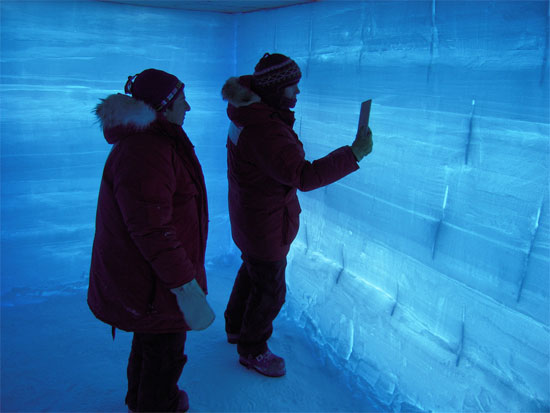Again discovered aphids in Antarctic ice sheets
New Zealand scientists on May 21 found a tiny bug in Antarctic ice sheets.
This aphid species was first discovered in 1960, which is evidence of the impact of climate change, when the temperature is warmer.

Scientists examine the ice inside a snow hole in Antarctica. (Source: dailyclimate.org)
Researchers at the University of Waikato (New Zealand), said the rediscovery of the white- spotted mealybug , which is only 1 millimeter long, is extremely important. This weak creature can still survive, evidence of the impact of climate change in this frozen continent.
The temperature is getting warmer, helping ancient species living in the ice have a chance of "rebirth".
Researcher Kristi Bennett has identified two types of bugs and is working to find all tailed bug residents in the ice, in order to find ways to preserve them.
Ms. Bennett said: "We can use genetic factors to determine how long the two tailed residents survived. This can provide evidence that shows what happened to the landscape. Ecology here. "
Earlier, Professor Casey Hubert of the University of Newcastle (UK) and colleagues analyzed a bacterial population in sediment samples at the bottom of the Arctic Ocean.
Scientists have predicted that bacteria will become more flexible when the temperature rises to 20 degrees C (equivalent to 68 degrees F).
- Ice area increased record in Antarctica
- Antarctica: Ice is breaking down from below
- Antarctic snow ice is not only white
- What mystery makes the Antarctic ice sheet green?
- The formation of Antarctic glaciers
- Ice layers at Mount Angola, memorandum of rainfall
- Antarctic ice is melting faster than scientific forecast
- A mollusk discovered in the Antarctic abyss
- Ladybug is 'biological weapon' in the supermarket
- The Antarctic ice shelf shattered, threatening to drown many cities
- Roofing from garbage
- Read this article, you will give up the habit of using red and black bed sheets
 Why do potatoes have eyes?
Why do potatoes have eyes? 'Tragedy' the world's largest carnivorous life: Death becomes ... public toilet
'Tragedy' the world's largest carnivorous life: Death becomes ... public toilet Tomatoes were once considered 'poisonous' for 200 years
Tomatoes were once considered 'poisonous' for 200 years Detecting microscopic parasites on human face
Detecting microscopic parasites on human face